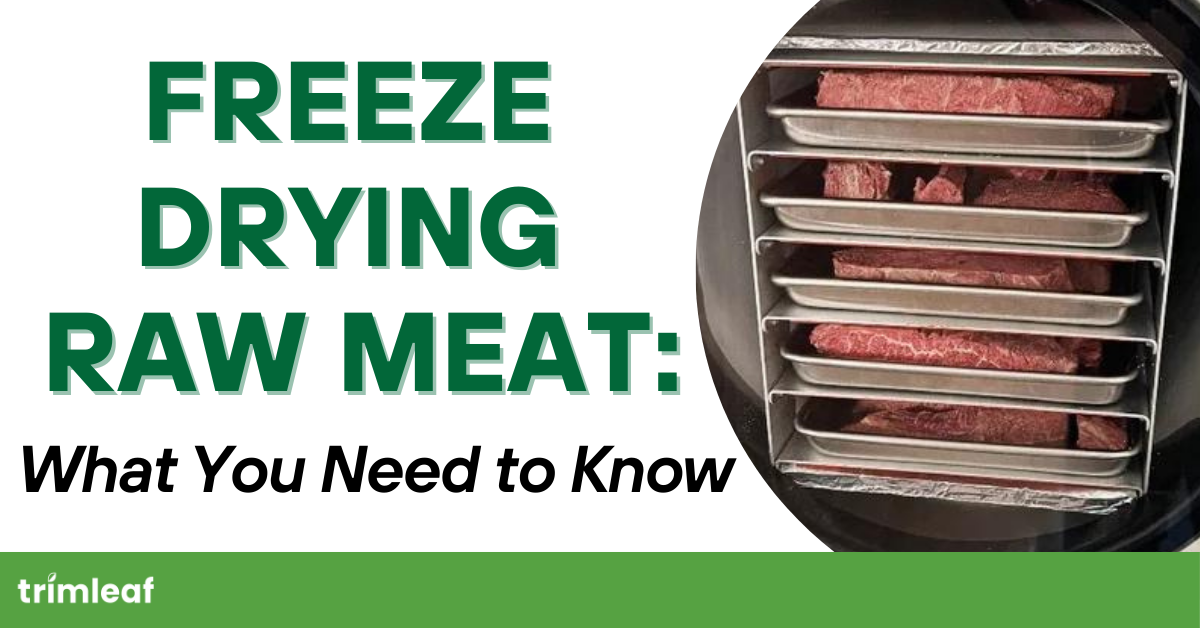
Freeze drying has gained popularity for its ability to extend the shelf life of various foods, including meat.
Its ability to remove moisture from food while preserving its structure and nutrients has allowed it to become the choice of many home preppers to ensure a sufficient food supply for long-term storage.
If you come across a good deal at the butcher shop, you might want to portion them for freeze-drying. This way, you can keep them suitable for a variety of future dishes, adding a new dimension to your culinary adventures.
Table of Contents
Best Cuts for Freeze Drying

Not all cuts are created equal when freeze-drying meat, whether raw or cooked. To ensure the best results, there are a few things to consider when choosing your protein.
Lean cuts of meat such as poultry breasts, sirloin steaks, and pork loin cuts, which contain less fat and moisture, are generally the most suitable choice for freeze-drying
Ground meat is also a great option! Lean ground beef or turkey is a versatile ingredient that can be easily rehydrated and used in soups, stews, or sauces.
Cuts to Avoid for Freeze Drying

Be cautious with fatty cuts of meat. Brisket, pork belly, and other cuts with a high-fat content can be a challenge to freeze-dry. The excess fat can slow down the drying process and potentially lead to spoilage during storage.
If you can't resist these cuts, consider trimming excess fat before freeze-drying them.
Processed meats like bacon, hot dogs, and sausages are not be the best candidates for freeze-drying as well. These meats often contain added fats and preservatives that may not freeze-dry well and could affect the final texture or flavor.
Benefits of Freeze-Drying Meat

Freeze-drying meat offers unique benefits, making it a superior choice for long-term storage.
Although the freeze-drying process helps inhibit bacterial growth, it doesn't eliminate all microorganisms in the meat. So, always cook your freeze-dried meat thoroughly before eating to stay safe to prevent the risk of foodborne illnesses by cooking the meat thoroughly.
How to Freeze Dry Raw Meat
Freeze-drying meat is a meticulous process that requires careful preparation to achieve the best results. If you follow these instructions and pay close attention to detail, you can easily freeze dry meat at home with confidence.
Step 1: Ready Freeze Dryer Trays

Before diving into meat prep, let's get your freeze dryer ready. Line the trays with parchment paper or silicone mats. These liners help prevent sticking and make cleanup a breeze.
Parchment paper is readily available; you can even buy pre-cut ones on amazon but non-stick mats offer the advantage of reusability. Choose whichever best suits your needs and set the lined trays aside for now.
Step 2: Prepare the Meat

Now, it's time to choose your protein of choice! Ground beef, chicken breasts, fish fillets – the possibilities are endless. For optimal results, select fresh, high-quality cuts of meat.
Remove any bones or excess fat. You want the meat to be relatively lean, as fat takes longer to freeze-dry and can impact the final texture.
Then, cut the meat into uniform pieces to promote even drying and get consistent results. Aim for pieces no thicker than an inch. Anything thicker will dry unevenly and result in a tough, brick-like texture.
Step 3: Set Your Freeze Dryer

With your meat prepped and trays lined, it's time to turn on your freeze dryer. Refer to your machine's manual for the recommended settings for freeze-drying meat.
Most models offer specific settings optimized for different types of food, including meat.
Step 4: Load the Trays

Now comes the fun part: arranging your meat on the trays!
Carefully place the meat pieces on the lined trays, ensuring ample space between each piece. Overcrowding the trays can hinder proper airflow and slow down the drying process.
Step 5: Let the Freeze-Drying Begin!

Once you've loaded the trays with your perfectly spaced meat pieces, carefully place them inside the freeze dryer. Set a timer for the recommended settings for your chosen type of meat.
If your freeze dryer does not have a preset for meats, try freeze-drying them anywhere between -30 and -50 degrees Fahrenheit (-45.56 °C).
Check your freeze dryer's manual or manufacturer's chart for specific drying time and temperature settings. Some models, like the Harvest Right, even have built-in sensors that notify you when the food is thoroughly freeze-dried.
As a rule of thumb, the freeze-drying process typically takes several hours, with more extensive or denser cuts requiring longer cycles. In some cases, the process can go as long as 40 hours.
How Do I Determine If the Raw Meat Is Completely Freeze-Dried?

To check if the meat is fully freeze-dried, remove a piece of meat from the freezer and let it come to room temperature.
Then, gently squeeze the meat between your fingers. Fully freeze-dried meat should feel dry and brittle, with no signs of moisture or flexibility.
If the meat feels soft or bendable, it may require additional drying time. Continue to test as needed until all pieces exhibit the desired texture and consistency.
Storing Freeze Dried Meat

Once the meat has been freeze-dried, proper storage is essential to maintain its quality and extend its shelf life. Store the sealed containers of freeze-dried meat in a cool, dry, and dark environment to maximize shelf life.
You may want to consider adding oxygen absorbers to the containers before sealing them to further reduce the risk of oxidation and spoilage. This extra precaution helps preserve the quality and flavor of the freeze-dried meat over time.
Avoid exposing the containers to direct sunlight or fluctuating temperatures, as these conditions can accelerate degradation and compromise the quality of the meat.
A pantry, cellar, or cupboard away from heat sources and moisture is ideal for storing freeze-dried meat.
Rehydrating and Cooking
Once you plan to use your freeze-dried meat, you must rehydrate it before consumption. There are several methods for rehydrating freeze-dried meat, each suited to different culinary applications and preferences.
Again, cook freeze-dried raw meat thoroughly before consumption, since some microorganisms may still be present. Whether you're grilling, sautéing, or simmering, treat freeze-dried raw meat with the same care and attention as fresh meat to enjoy delicious and safe meals.
Conclusion
Freeze-drying meat is highly effective for preserving its nutritional value, extending its shelf life, and providing a lightweight, convenient food option for various needs.
Whether you're a home chef, culinary expert, prepper, or outdoor adventurer, freeze-drying provides numerous benefits for having ready-to-eat meat supplies.
You can secure the long-lasting and high-quality preservation of meat by choosing lean cuts, following precise steps, and storing the freeze-dried product correctly.
Once you get the hang of freeze-drying meat, you’ll find it a great addition to your supplies, keeping you ready even when you don’t have time to prepare meals quickly.
Want to learn more about freeze-drying foods and treats? Check these out:
- Starting a Freeze-Drying Food Business? Here's What You Need to Know
- How to Freeze Dry Candy
- Best Freeze Dryer for Candy
- Is Freeze-Dried Fruit Healthy? What You Need to Know
Frequently Asked Questions About Freeze Drying Meat
- Is freeze-dried meat safe to eat?
- Yes, freeze-dried meat is safe to eat as long as it has been properly prepared and stored. It is important to follow guidelines for rehydrating and consuming freeze-dried meats to ensure their safety.
-
- Can freeze-dried meat be stored long-term?
- Yes, freeze-dried meat can be stored long-term if kept in airtight containers with proper packaging such as mylar bags and oxygen absorbers. This prevents moisture reabsorption and ensures long-term storage.
- What equipment is used for freeze-drying meat?
- Freeze dryers are used for freeze-drying meat. Harvest Right is a popular brand that makes home freeze dryers. However, there are various freeze dryer models available depending on your needs and budget.
-
- How long does freeze-dried meat last?
- The shelf life of freeze-dried meat can vary, but when stored in an airtight container with an oxygen absorber and proper conditions. Properly stored freeze-dried meat can last for 25 years or more, making it a great emergency food option.
- What are the drawbacks of freeze-dried meat?
- Freeze-dried meat can be more expensive than fresh or frozen meat. The freeze-drying process can also alter the texture slightly.
- Can I use freeze-dried meat for everyday meals?
- Yes! Freeze-dried meat can be rehydrated and used in various recipes like stews, stir-fries, or casseroles.
- Where can I buy freeze-dried meat?
- Freeze-dried meat can be found online from specialty retailers or outdoor gear stores. Some grocery stores might also carry a limited selection.
- How long does it take to freeze-dry meat at home?
- The freeze-drying time varies depending on the thickness of the meat cut and your machine's settings. It typically takes 24 hours or more.
- Can I refreeze freeze-dried meat after rehydration?
- No, refreezing rehydrated freeze-dried meat is not recommended as it can affect the texture and increase the risk of spoilage.
- Does freeze-dried meat require any special preparation before cooking?
- No, once rehydrated, freeze-dried meat can be cooked using the same methods as fresh meat.
- What are some creative ways to use freeze-dried meat?
- Freeze-dried meat can be used in various ways beyond camping meals. Consider adding it to trail mixes, homemade jerky, or even grinding it into a powder for use in sauces or dips.
- Is freeze-drying meat an eco-friendly option?
- Freeze-drying can reduce food waste by preserving meat for extended periods. However, the energy consumption of freeze dryers needs to be considered for its environmental impact.




